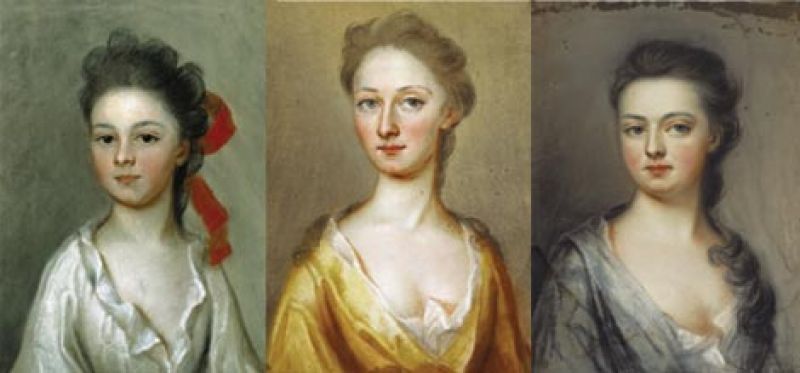
(Clockwise from top): Johnston’s 1711 portrait of 11-year-old Henriette Charlotte Chastaigner is among her most vibrant Charles Towne works. The artist painted Anne Du Bose circa 1720 and her sister, Marie, in 1708.
When picturing Charleston’s early heroes, the swashbuckling pirate fighter William Rhett may come to mind. Ironically, the fact that we have an image of him—as well as other prominent citizens of the city—at all is due to the little-known heroine, Henrietta Johnston, who painted him.
She was born about 1674, possibly in Northern France or England, into the de Beaulieu family of Huguenots. Moving to London in 1687, she married Robert Dering and settled in Ireland. It was after Dering died in 1703 that the now-single mother of two began painting pastel portraits—particularly of earls and other members of her late husband’s extended family. In 1705, she married Rev. Gideon Johnston, who was appointed by the Society for the Propagation in Foreign Parts—a missionary division of the Church of England—as commissary for the South Carolina colony and rector of St. Philip’s Church in Charles Towne. As it turned out, this position required the patience of Job, for once the Johnstons arrived in America, Gideon’s entreaties for payment from the society often went unheeded.
Gideon wrote in a letter to the society that he relied financially on the “assistance my wife gives me by drawing of Pictures,” supplying proof that she was by this time charging for her portraits. Henrietta Johnston had become the first female professional artist in America. She is also proclaimed the continent’s first pastelist, as she continued using the medium, despite that its scarcity in the New World required her to paint smaller portraits using different hues.
In 1711, Henrietta sailed to England to deliver documents to the society—and to plead her husband’s case. Taking along packets of rice as souvenirs, she convinced the society to increase and guarantee Gideon’s salary and to reimburse him in “Consideration of the Great Services pains and Losses” he had sustained. Once she returned to Carolina—no doubt with more art supplies—her husband departed for his own trip to England, leaving Henrietta alone when the Yamasee War erupted in 1715. Not long after Gideon arrived home, he was killed in a boating accident.
Displaying the pluck that had taken her to Ireland and the New World, Henrietta traveled north, fulfilling commissions in New York City in the 1720s. She returned to Charleston, where she died in 1729. Her tombstone in St. Philip’s cemetery has disappeared, but more than 40 of her very fragile pastels have survived. Several are included in the Gibbes Museum of Art’s “Breaking Down Barriers: 300 Years of Women in Art” exhibit, opening October 28. Gazing at them, we see those who once looked upon the amazingly brave and talented trailblazer Henrietta Johnston.
“Breaking Down Barriers: 300 Years of women in art”: Gibbes Museum of Art, 135 Meeting St. October 28, 2011-January 8, 2012, Tuesday-Saturday, 10 a.m.-5 p.m.; Sunday, 1-5 p.m. (843) 722-2706, www.gibbesmuseum.org